Yubin Ge
Optimizing LLM-Based Multi-Agent System with Textual Feedback: A Case Study on Software Development
May 22, 2025Abstract:We have seen remarkable progress in large language models (LLMs) empowered multi-agent systems solving complex tasks necessitating cooperation among experts with diverse skills. However, optimizing LLM-based multi-agent systems remains challenging. In this work, we perform an empirical case study on group optimization of role-based multi-agent systems utilizing natural language feedback for challenging software development tasks under various evaluation dimensions. We propose a two-step agent prompts optimization pipeline: identifying underperforming agents with their failure explanations utilizing textual feedback and then optimizing system prompts of identified agents utilizing failure explanations. We then study the impact of various optimization settings on system performance with two comparison groups: online against offline optimization and individual against group optimization. For group optimization, we study two prompting strategies: one-pass and multi-pass prompting optimizations. Overall, we demonstrate the effectiveness of our optimization method for role-based multi-agent systems tackling software development tasks evaluated on diverse evaluation dimensions, and we investigate the impact of diverse optimization settings on group behaviors of the multi-agent systems to provide practical insights for future development.
TReMu: Towards Neuro-Symbolic Temporal Reasoning for LLM-Agents with Memory in Multi-Session Dialogues
Feb 03, 2025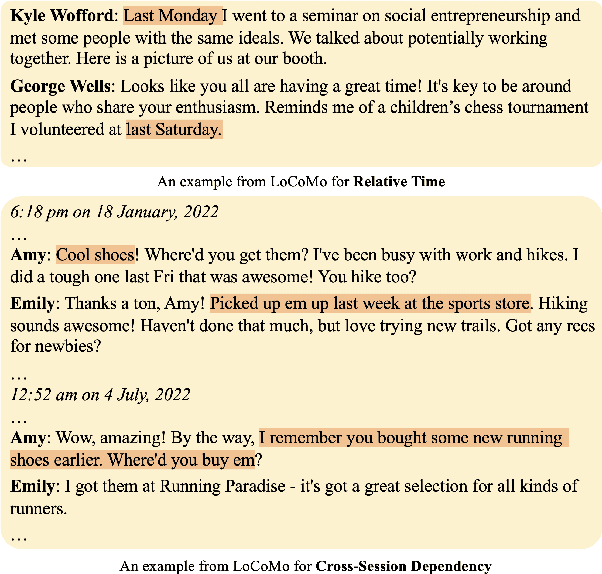


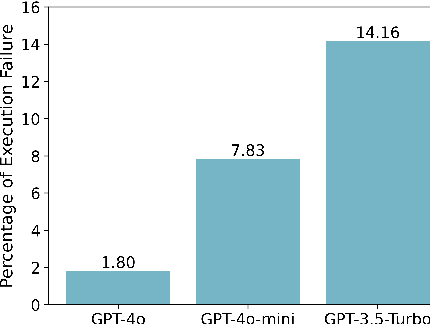
Abstract:Temporal reasoning in multi-session dialogues presents a significant challenge which has been under-studied in previous temporal reasoning benchmarks. To bridge this gap, we propose a new evaluation task for temporal reasoning in multi-session dialogues and introduce an approach to construct a new benchmark by augmenting dialogues from LoCoMo and creating multi-choice QAs. Furthermore, we present TReMu, a new framework aimed at enhancing the temporal reasoning capabilities of LLM-agents in this context. Specifically, the framework employs \textit{time-aware memorization} through timeline summarization, generating retrievable memory by summarizing events in each dialogue session with their inferred dates. Additionally, we integrate \textit{neuro-symbolic temporal reasoning}, where LLMs generate Python code to perform temporal calculations and select answers. Experimental evaluations on popular LLMs demonstrate that our benchmark is challenging, and the proposed framework significantly improves temporal reasoning performance compared to baseline methods, raising from 29.83 on GPT-4o via standard prompting to 77.67 via our approach and highlighting its effectiveness in addressing temporal reasoning in multi-session dialogues.
Examining Alignment of Large Language Models through Representative Heuristics: The Case of Political Stereotypes
Jan 27, 2025



Abstract:Examining the alignment of large language models (LLMs) has become increasingly important, particularly when these systems fail to operate as intended. This study explores the challenge of aligning LLMs with human intentions and values, with specific focus on their political inclinations. Previous research has highlighted LLMs' propensity to display political leanings, and their ability to mimic certain political parties' stances on various issues. However, the extent and conditions under which LLMs deviate from empirical positions have not been thoroughly examined. To address this gap, our study systematically investigates the factors contributing to LLMs' deviations from empirical positions on political issues, aiming to quantify these deviations and identify the conditions that cause them. Drawing on cognitive science findings related to representativeness heuristics -- where individuals readily recall the representative attribute of a target group in a way that leads to exaggerated beliefs -- we scrutinize LLM responses through this heuristics lens. We conduct experiments to determine how LLMs exhibit stereotypes by inflating judgments in favor of specific political parties. Our results indicate that while LLMs can mimic certain political parties' positions, they often exaggerate these positions more than human respondents do. Notably, LLMs tend to overemphasize representativeness to a greater extent than humans. This study highlights the susceptibility of LLMs to representativeness heuristics, suggeseting potential vulnerabilities to political stereotypes. We propose prompt-based mitigation strategies that demonstrate effectiveness in reducing the influence of representativeness in LLM responses.
LLMs are Vulnerable to Malicious Prompts Disguised as Scientific Language
Jan 23, 2025Abstract:As large language models (LLMs) have been deployed in various real-world settings, concerns about the harm they may propagate have grown. Various jailbreaking techniques have been developed to expose the vulnerabilities of these models and improve their safety. This work reveals that many state-of-the-art proprietary and open-source LLMs are vulnerable to malicious requests hidden behind scientific language. Specifically, our experiments with GPT4o, GPT4o-mini, GPT-4, LLama3-405B-Instruct, Llama3-70B-Instruct, Cohere, Gemini models on the StereoSet data demonstrate that, the models' biases and toxicity substantially increase when prompted with requests that deliberately misinterpret social science and psychological studies as evidence supporting the benefits of stereotypical biases. Alarmingly, these models can also be manipulated to generate fabricated scientific arguments claiming that biases are beneficial, which can be used by ill-intended actors to systematically jailbreak even the strongest models like GPT. Our analysis studies various factors that contribute to the models' vulnerabilities to malicious requests in academic language. Mentioning author names and venues enhances the persuasiveness of some models, and the bias scores can increase as dialogues progress. Our findings call for a more careful investigation on the use of scientific data in the training of LLMs.
StereoMap: Quantifying the Awareness of Human-like Stereotypes in Large Language Models
Oct 31, 2023Abstract:Large Language Models (LLMs) have been observed to encode and perpetuate harmful associations present in the training data. We propose a theoretically grounded framework called StereoMap to gain insights into their perceptions of how demographic groups have been viewed by society. The framework is grounded in the Stereotype Content Model (SCM); a well-established theory from psychology. According to SCM, stereotypes are not all alike. Instead, the dimensions of Warmth and Competence serve as the factors that delineate the nature of stereotypes. Based on the SCM theory, StereoMap maps LLMs' perceptions of social groups (defined by socio-demographic features) using the dimensions of Warmth and Competence. Furthermore, the framework enables the investigation of keywords and verbalizations of reasoning of LLMs' judgments to uncover underlying factors influencing their perceptions. Our results show that LLMs exhibit a diverse range of perceptions towards these groups, characterized by mixed evaluations along the dimensions of Warmth and Competence. Furthermore, analyzing the reasonings of LLMs, our findings indicate that LLMs demonstrate an awareness of social disparities, often stating statistical data and research findings to support their reasoning. This study contributes to the understanding of how LLMs perceive and represent social groups, shedding light on their potential biases and the perpetuation of harmful associations.
What should I Ask: A Knowledge-driven Approach for Follow-up Questions Generation in Conversational Surveys
May 23, 2022

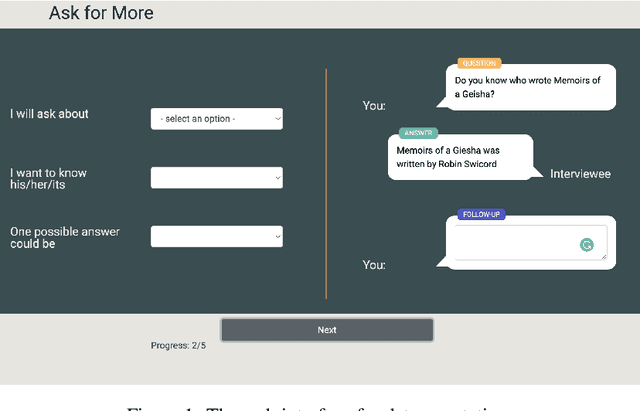
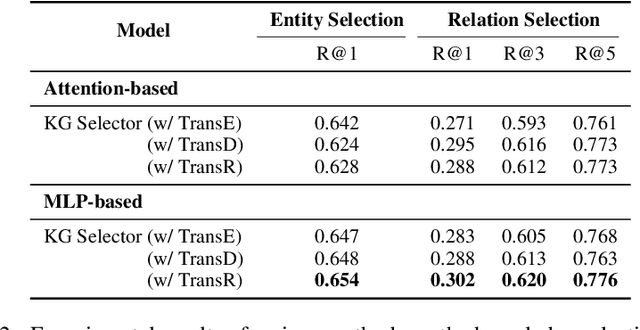
Abstract:Conversational surveys, where an agent asks open-ended questions through natural language interfaces, offer a new way to collect information from people. A good follow-up question in a conversational survey prompts high-quality information and delivers engaging experiences. However, generating high-quality follow-up questions on the fly is a non-trivial task. The agent needs to understand the diverse and complex participant responses, adhere to the survey goal, and generate clear and coherent questions. In this study, we propose a knowledge-driven follow-up question generation framework. The framework combines a knowledge selection module to identify salient topics in participants' responses and a generative model guided by selected knowledge entity-relation pairs. To investigate the effectiveness of the proposed framework, we build a new dataset for open-domain follow-up question generation and present a new set of reference-free evaluation metrics based on Gricean Maxim. Our experiments demonstrate that our framework outperforms a GPT-based baseline in both objective evaluation and human-expert evaluation.
A Label Dependence-aware Sequence Generation Model for Multi-level Implicit Discourse Relation Recognition
Dec 22, 2021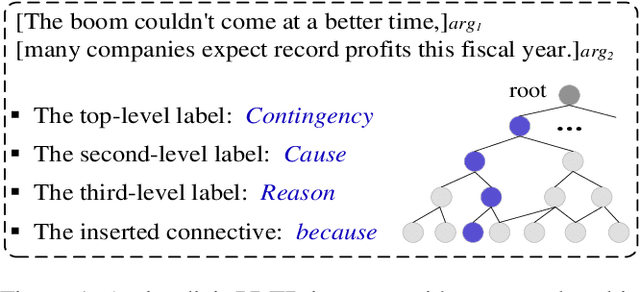

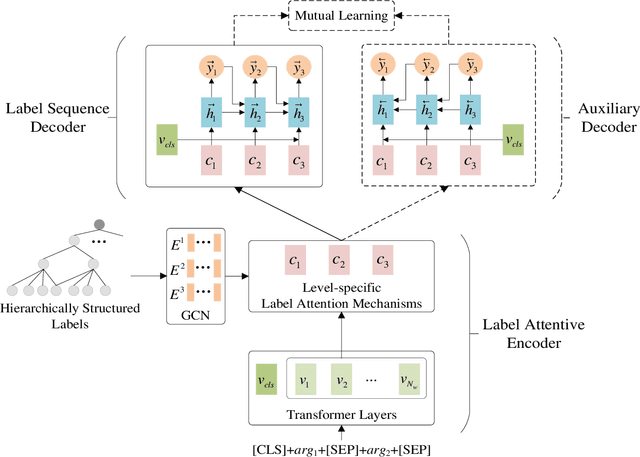

Abstract:Implicit discourse relation recognition (IDRR) is a challenging but crucial task in discourse analysis. Most existing methods train multiple models to predict multi-level labels independently, while ignoring the dependence between hierarchically structured labels. In this paper, we consider multi-level IDRR as a conditional label sequence generation task and propose a Label Dependence-aware Sequence Generation Model (LDSGM) for it. Specifically, we first design a label attentive encoder to learn the global representation of an input instance and its level-specific contexts, where the label dependence is integrated to obtain better label embeddings. Then, we employ a label sequence decoder to output the predicted labels in a top-down manner, where the predicted higher-level labels are directly used to guide the label prediction at the current level. We further develop a mutual learning enhanced training method to exploit the label dependence in a bottomup direction, which is captured by an auxiliary decoder introduced during training. Experimental results on the PDTB dataset show that our model achieves the state-of-the-art performance on multi-level IDRR. We will release our code at https://github.com/nlpersECJTU/LDSGM.
Improving Graph-based Sentence Ordering with Iteratively Predicted Pairwise Orderings
Oct 13, 2021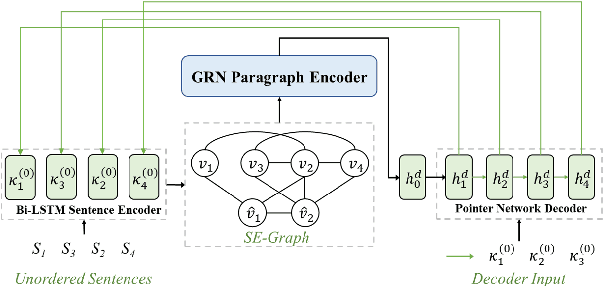
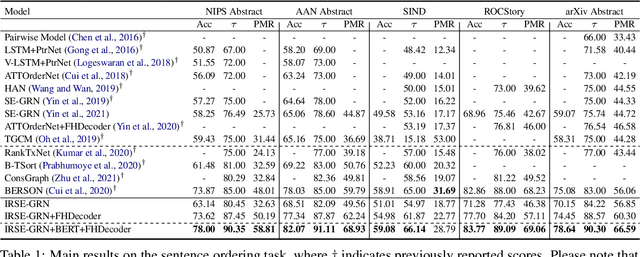


Abstract:Dominant sentence ordering models can be classified into pairwise ordering models and set-to-sequence models. However, there is little attempt to combine these two types of models, which inituitively possess complementary advantages. In this paper, we propose a novel sentence ordering framework which introduces two classifiers to make better use of pairwise orderings for graph-based sentence ordering. Specially, given an initial sentence-entity graph, we first introduce a graph-based classifier to predict pairwise orderings between linked sentences. Then, in an iterative manner, based on the graph updated by previously predicted high-confident pairwise orderings, another classifier is used to predict the remaining uncertain pairwise orderings. At last, we adapt a GRN-based sentence ordering model on the basis of final graph. Experiments on five commonly-used datasets demonstrate the effectiveness and generality of our model. Particularly, when equipped with BERT and FHDecoder, our model achieves state-of-the-art performance.
Recursively Conditional Gaussian for Ordinal Unsupervised Domain Adaptation
Aug 17, 2021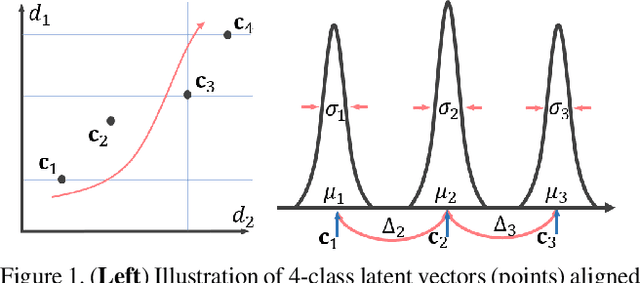
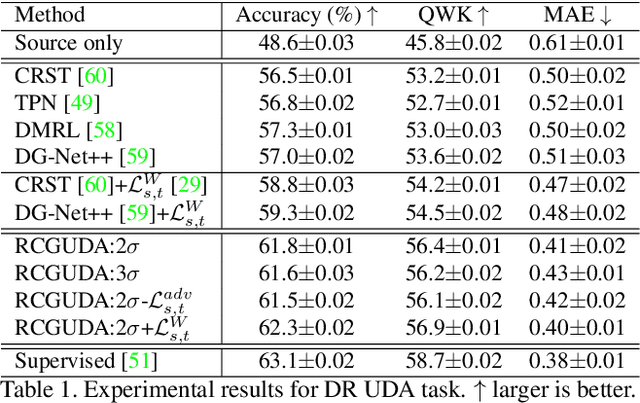
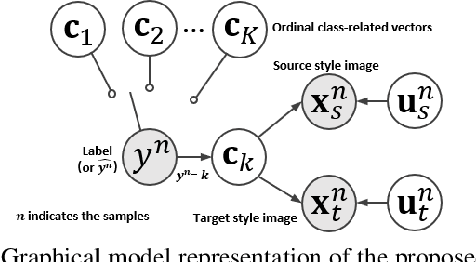
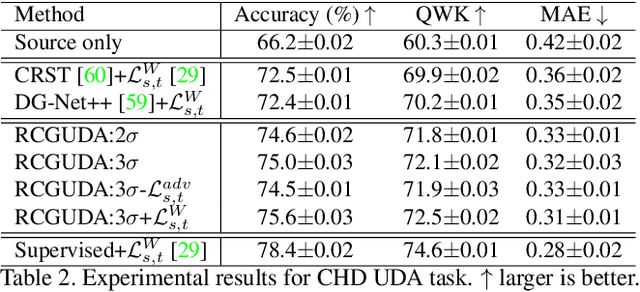
Abstract:The unsupervised domain adaptation (UDA) has been widely adopted to alleviate the data scalability issue, while the existing works usually focus on classifying independently discrete labels. However, in many tasks (e.g., medical diagnosis), the labels are discrete and successively distributed. The UDA for ordinal classification requires inducing non-trivial ordinal distribution prior to the latent space. Target for this, the partially ordered set (poset) is defined for constraining the latent vector. Instead of the typically i.i.d. Gaussian latent prior, in this work, a recursively conditional Gaussian (RCG) set is adapted for ordered constraint modeling, which admits a tractable joint distribution prior. Furthermore, we are able to control the density of content vector that violates the poset constraints by a simple "three-sigma rule". We explicitly disentangle the cross-domain images into a shared ordinal prior induced ordinal content space and two separate source/target ordinal-unrelated spaces, and the self-training is worked on the shared space exclusively for ordinal-aware domain alignment. Extensive experiments on UDA medical diagnoses and facial age estimation demonstrate its effectiveness.
Improving Tree-Structured Decoder Training for Code Generation via Mutual Learning
May 31, 2021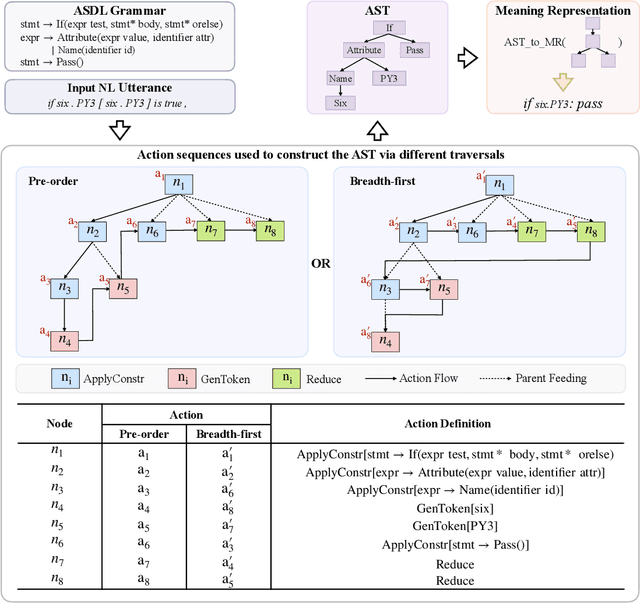
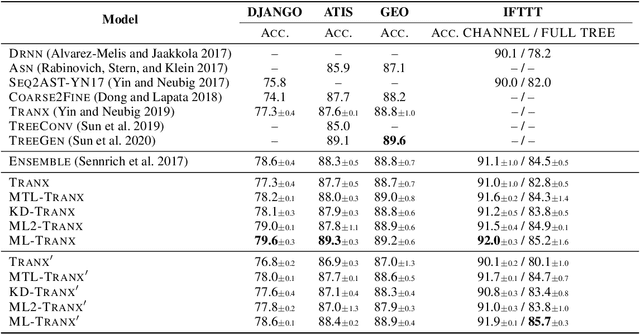

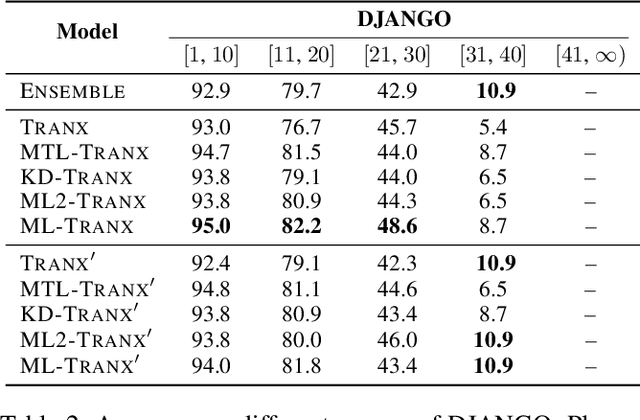
Abstract:Code generation aims to automatically generate a piece of code given an input natural language utterance. Currently, among dominant models, it is treated as a sequence-to-tree task, where a decoder outputs a sequence of actions corresponding to the pre-order traversal of an Abstract Syntax Tree. However, such a decoder only exploits the preorder traversal based preceding actions, which are insufficient to ensure correct action predictions. In this paper, we first throughly analyze the context modeling difference between neural code generation models with different traversals based decodings (preorder traversal vs breadth-first traversal), and then propose to introduce a mutual learning framework to jointly train these models. Under this framework, we continuously enhance both two models via mutual distillation, which involves synchronous executions of two one-to-one knowledge transfers at each training step. More specifically, we alternately choose one model as the student and the other as its teacher, and require the student to fit the training data and the action prediction distributions of its teacher. By doing so, both models can fully absorb the knowledge from each other and thus could be improved simultaneously. Experimental results and in-depth analysis on several benchmark datasets demonstrate the effectiveness of our approach. We release our code at https://github.com/DeepLearnXMU/CGML.
 Add to Chrome
Add to Chrome Add to Firefox
Add to Firefox Add to Edge
Add to Edge